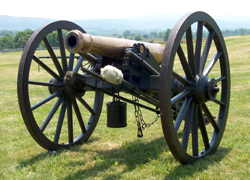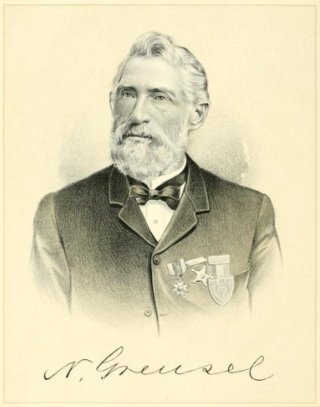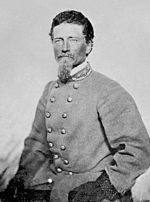
The Battle of Pea Ridge, also known as the Battle of Elkhorn Tavern, took place during the American Civil War near Leetown, northeast of Fayetteville, Arkansas. Federal forces, led by Brig. Gen. Samuel R. Curtis, moved south from central Missouri, driving Confederate forces into northwestern Arkansas. Maj. Gen. Earl Van Dorn had launched a Confederate counteroffensive, hoping to recapture northern Arkansas and Missouri. Confederate forces met at Bentonville and became the most substantial Rebel force, by way of guns and men, to assemble in the Trans-Mississippi. Against odds Curtis held off the Confederate attack on the first day and drove Van Dorn's force off the battlefield on the second. By defeating the Confederates, the Union forces established Federal control of most of Missouri and northern Arkansas.

The Army of the West, also known as the Trans-Mississippi District, was a formation of the Confederate States Army during the American Civil War that was a part of the Army of Mississippi. It saw action in the Battle of Pea Ridge, Battle of Corinth, and Battle of Iuka and consisted of about 20,000 personnel.
The 1st Missouri Infantry was an infantry regiment that served in the Confederate States Army during the American Civil War. Originally commanded by Colonel John S. Bowen, the regiment fought at the Battle of Shiloh, where it was engaged near the Peach Orchard on April 6, 1862. On April 7, during the Union counterattacks at Shiloh, the regiment was instrumental in preventing the Washington Artillery from being captured. The regiment was next engaged at the Second Battle of Corinth, where it outflanked several Union positions. On the second day at Corinth, the regiment was only minimally engaged. On November 7, the 1st Missouri Infantry was combined with the 4th Missouri Infantry to form the 1st and 4th Missouri Infantry (Consolidated), as a result of heavy battle losses in both regiments.
The 1st Arkansas Cavalry Battalion (Stirman's) (1864–1865) was a Confederate Army cavalry battalion during the American Civil War. The unit was also known as Brooks 1st Arkansas Cavalry Battalion, Stirman's, 1st Arkansas Cavalry Battalion, Stirman's Sharpshooter Regiment, 1st Regiment Arkansas Sharpshooters, and finally simply as Stirman's Arkansas Cavalry Regiment.

The 9th Texas Cavalry Regiment was a unit of mounted volunteers that fought in the Confederate States Army during the American Civil War. The regiment fought at Round Mountain and Bird Creek (Chusto-Talasah) in 1861, Pea Ridge, Siege of Corinth, Second Corinth, Hatchie's Bridge and the Holly Springs Raid in 1862, and in the Atlanta campaign, Franklin, and Murfreesboro in 1864. The unit fought dismounted at Second Corinth and Hatchie's Bridge before being remounted as cavalry for the remainder of the war. The regiment surrendered to Federal forces on 4 May 1865 and its remaining personnel were paroled.

The 15th Texas Cavalry Regiment was a unit of cavalry volunteers mustered into the Confederate States Army in March 1862 and fought during the American Civil War. In July 1862 the unit was dismounted and served the remainder of the war as infantry. The regiment was captured at Arkansas Post in January 1863. After being exchanged three months later, the much-reduced 15th Texas was consolidated with two other regiments and assigned to Patrick Cleburne's division in the Army of Tennessee. The consolidated regiment fought at Chickamauga, Missionary Ridge, and Ringgold Gap in 1863. After a re-consolidation, the regiment fought in the Atlanta Campaign, and at Franklin and Nashville in 1864. After a final consolidation the troops fought at Averasborough and Bentonville in 1865. The regiment's 43 surviving soldiers surrendered to Federal forces on 26 April 1865.

The 32nd Texas Cavalry Regiment, sometimes incorrectly named Andrews's 15th Texas Cavalry Regiment, was a unit of volunteer cavalry mustered into the Confederate States Army in May 1862 and which fought during the American Civil War. The regiment was formed around companies from Richard Phillip Crump's 1st Texas Cavalry Battalion which fought in Indian Territory and at Pea Ridge. Many of the soldiers died of disease in the unhealthy camps near Corinth, Mississippi. The cavalrymen were dismounted in July 1862 and served as infantry for the rest of the war. The regiment fought at Richmond, Ky., Stones River, and Chickamauga in 1862–1863, in the Meridian and Atlanta campaigns and at Nashville in 1864, and at Spanish Fort and Fort Blakeley in 1865. The regiment's 58 surviving members surrendered to Federal forces on 9 May 1865.

Douglas's Texas Battery was an artillery battery that served in the Confederate States Army during the American Civil War. In June 1861, the unit was formed by combining one group of men from Dallas with a second group from Tyler and placing them under the command of John Jay Good. The battery fought at Pea Ridge in March 1862 and soon afterward transferred to the east side of the Mississippi River. James Postell Douglas replaced Good as commander and led the battery at Richmond, Stones River, Chickamauga, Chattanooga, the Atlanta Campaign, Franklin, and Nashville. After operations around Mobile, Alabama, Confederate units in the region surrendered and the survivors of the battery were paroled on 12 May 1865. It was the only Texas field artillery unit that served east of the Mississippi.

Nicholas Greusel commanded the 36th Illinois Infantry Regiment during the early part of the American Civil War. As a teenager, he emigrated from the Kingdom of Bavaria to the United States. Later moving to Detroit, he was elected to political office for two years. He led a Michigan volunteer company during the Mexican-American War and later moved to Illinois. At the start of the Civil War he joined a three-month Illinois regiment, rising to field officer rank before the state governor appointed him colonel of the 36th Illinois. He led a brigade at the battles of Pea Ridge and Perryville and at the Siege of Corinth. At the Battle of Stones River he assumed command of the brigade when its commander was killed. He resigned because of poor health soon after Stones River and worked for the Chicago, Burlington and Quincy Railroad. He espoused pacifism in his later years.

The 16th Texas Cavalry Regiment was a unit of mounted volunteers from Texas that fought in the Confederate States Army during the American Civil War. The regiment was recruited in early 1862 and mustered into Confederate service in April 1862. The unit fought as cavalry at the Battle of Cotton Plant but it was dismounted in the summer of 1862. The 16th Cavalry served as infantry in Walker's Texas Division for the remainder of the war. The regiment fought at Milliken's Bend, Mansfield, Pleasant Hill, and Jenkins' Ferry. The unit marched to Texas in early 1865 and disbanded in May 1865.

The 3rd Texas Cavalry Regiment or South Kansas-Texas Mounted Volunteers was a unit of mounted volunteers that fought in the Confederate States Army during the American Civil War. The regiment fought at Wilson's Creek and Chustenahlah in 1861, Pea Ridge, Corinth siege, Iuka, Second Corinth, and the Holly Springs Raid in 1862, Thompson's Station in 1863, and at Yazoo City, in the Atlanta campaign, and at Nashville in 1864. The regiment fought dismounted at Iuka and Second Corinth before being remounted for the rest of the war. The regiment surrendered to Federal forces in May 1865 and its remaining 207 men were paroled.

The 27th Texas Cavalry Regiment, at times also known as Whitfield's Legion or 1st Texas Legion or 4th Texas Cavalry Battalion, was a unit of mounted volunteers that fought in the Confederate States Army during the American Civil War. First organized as the 4th Texas Cavalry Battalion or Whitfield's Legion, the unit served dismounted at Pea Ridge and First Corinth. Additional companies from Texas were added and the unit was upgraded to the 27th Texas Cavalry Regiment or 1st Texas Legion later in 1862. Still dismounted, the unit fought at Iuka and Second Corinth. The regiment was remounted and fought at Holly Springs in 1862, Thompson's Station in 1863, and at Yazoo City, Atlanta, Franklin, and Third Murfreesboro in 1864. The regiment surrendered to Federal forces in May 1865 and its remaining soldiers were paroled.

The 3rd Louisiana Infantry Regiment was a unit of foot soldiers from Louisiana that fought in the Confederate States Army during the American Civil War. The regiment distinguished itself at Wilson's Creek in 1861. The 3rd Louisiana fought at Pea Ridge, First Corinth, Iuka, and Second Corinth in 1862. The unit defended Vicksburg in 1863 where it was captured. At Vicksburg, the unit's fortification was twice blown up by powerful land mines. The surviving soldiers were paroled and exchanged, after which they performed guard duty for the rest of the war.
Wade's Battery was an artillery battery in the Confederate States Army during the American Civil War. The battery was mustered into Confederate service on December 28, 1861; many of the members of the battery had previously served in the Missouri State Guard. Assigned to the First Missouri Brigade, the battery saw action at the Battle of Pea Ridge and the Second Battle of Corinth in 1862. In 1863, the battery fought at the Battle of Grand Gulf, where Captain William Wade, first commander of the battery, was killed. The battery later saw action at the Battle of Champion Hill, Battle of Big Black River Bridge, and the Siege of Vicksburg. When the Confederates surrendered at the end of the Siege of Vicksburg, the men of the battery became prisoners of war. After a prisoner exchange, the men of the battery were combined with Landis's Battery and Guibor's Battery on October 3, 1863, and Wade's Battery ceased to exist as a separate unit.
The 4th Missouri Infantry Regiment was formed on April 28, 1862, and served in the Confederate States Army during the American Civil War. The infantry regiment did not see action at the Battle of Farmington on May 9, and the Battle of Iuka on September 19 despite being part of the Confederate force present at those battles. As part of Brigadier General Martin E. Green's brigade, the regiment participated in three charges against Union lines on October 3, 1862, during the Second Battle of Corinth. The following day, the regiment, along with the rest of Green's brigade, attacked the new Union lines. Despite initial success, the attack was repulsed by a Union counterattack. The regiment ceased to exist as a separate unit when it was combined with the 1st Missouri Infantry Regiment on November 7, 1862, to form the 1st and 4th Missouri Infantry Regiment (Consolidated).
The 3rd Missouri Light Battery was an artillery battery of the Confederate States Army during the American Civil War. The battery originated as a Missouri State Guard unit active in late 1861, and was officially transferred to the Confederate States Army on January 28, 1862. The battery provided artillery support at the Battle of Pea Ridge in March 1862, and was lightly engaged at the Battle of Iuka in September. In October 1862, the battery was lightly engaged at the Second Battle of Corinth and saw action at the Battle of Davis Bridge, where it lost at least one cannon. The 3rd Light Battery saw action at the Battle of Champion Hill on May 16, 1863, and had its cannons captured at the Battle of Big Black River Bridge the next day. After participating in the Siege of Vicksburg, the battery was captured on July 4, 1863 and was paroled and exchanged. The battery was then consolidated with the Jackson Missouri Battery; the 3rd Light Battery designation was continued. In early 1864, the battery received replacement cannons and was assigned to the defense of Mobile Bay. The 3rd Light Battery saw action at the Battle of Spanish Fort in March and April 1865. When the Confederate Department of Alabama, Mississippi, and East Louisiana surrendered on May 4, 1865, the battery was again captured; the men of the battery were paroled on May 10, ending their military service.
The 2nd Missouri Infantry Regiment was an infantry regiment that served in the Confederate States Army during the American Civil War. Organized on January 16, 1862, the regiment first saw major action at the Battle of Pea Ridge on March 7 and 8, 1862. After Pea Ridge, the regiment was transferred across the Mississippi River, fighting in the Battle of Farmington, Mississippi on May 9. The unit missed the Battle of Iuka in September, but was heavily engaged at the Second Battle of Corinth on October 3 and 4. The regiment helped drive in a Union position on October 3. On October 4, the 2nd Missouri Infantry, along with the rest of Colonel Elijah Gates' brigade, captured a fortification known as Battery Powell, but were forced to retreat by Union reinforcements.
The 3rd Missouri Infantry Regiment served in the Confederate States Army during the American Civil War. The infantry regiment was officially mustered into service on January 17, 1862. It fought at the Battle of Pea Ridge in Arkansas in March before being transferred across the Mississippi River. While stationed at Corinth, Mississippi, the regiment played a minor role in the Battle of Farmington before the evacuation of the town. In September, the unit saw light action at the Battle of Iuka before being heavily engaged during the Second Battle of Corinth as the Confederates attempted to retake the town in October. In early 1863, the regiment was transferred to Grand Gulf, Mississippi, in order to strengthen the defenses of the Mississippi River at that point. At the Battle of Grand Gulf on April 29, the unit helped repulse a Union Navy attack against the Confederate defensive works. After elements of the Union Army of the Tennessee landed below Grand Gulf, the regiment fought in a delaying action at the Battle of Port Gibson on May 1.
Hiram Bledsoe's Missouri Battery was an artillery battery that served in the Missouri State Guard and the Confederate States Army during the American Civil War. The battery was formed when the Missouri State Guard was formed as a pro-secession state militia unit in response to the Camp Jackson affair. As part of the Missouri State Guard, the unit was engaged in the Engagement near Carthage and the Battle of Wilson's Creek during mid-1861, before fighting at the Battle of Dry Wood Creek and the Siege of Lexington later that year when Major General Sterling Price led the Guard northwards towards the Missouri River. After the Missouri State Guard retreated into Arkansas in early 1862, Bledsoe's Battery served during the Confederate defeat at the Battle of Pea Ridge in March. The battery, as part of the Army of the West, transferred across the Mississippi River into Tennessee in April, where it left the Guard to enter Confederate service on April 21.

The 24th and 25th Consolidated Texas Cavalry Regiment was a unit that originally consisted of two regiments of mounted volunteers that served in the Confederate States Army during the American Civil War. However, by the time the two regiments were consolidated, they fought as infantry. Both regiments organized as cavalry near Hempstead, Texas in April 1862 and were dismounted to fight as infantry in July 1862. The two regiments served in the same brigade and were captured at the Battle of Arkansas Post in January 1863. After being sent to Northern prison camps, the soldiers were exchanged in April 1863. Assigned to the Army of Tennessee, the two regiments were consolidated with two additional Texas cavalry regiments and in 1863 fought as infantry at Liberty Gap, Chickamauga, Missionary Ridge, and Ringgold Gap. In 1864, the other two Texas regiments were detached and the consolidated 24th and 25th fought as a separate infantry unit in the Atlanta campaign, at Franklin, and at Nashville. For the Carolinas campaign, the 24th and 25th fought at Bentonville before being reconsolidated with other Texas regiments and surrendering in April 1865.















